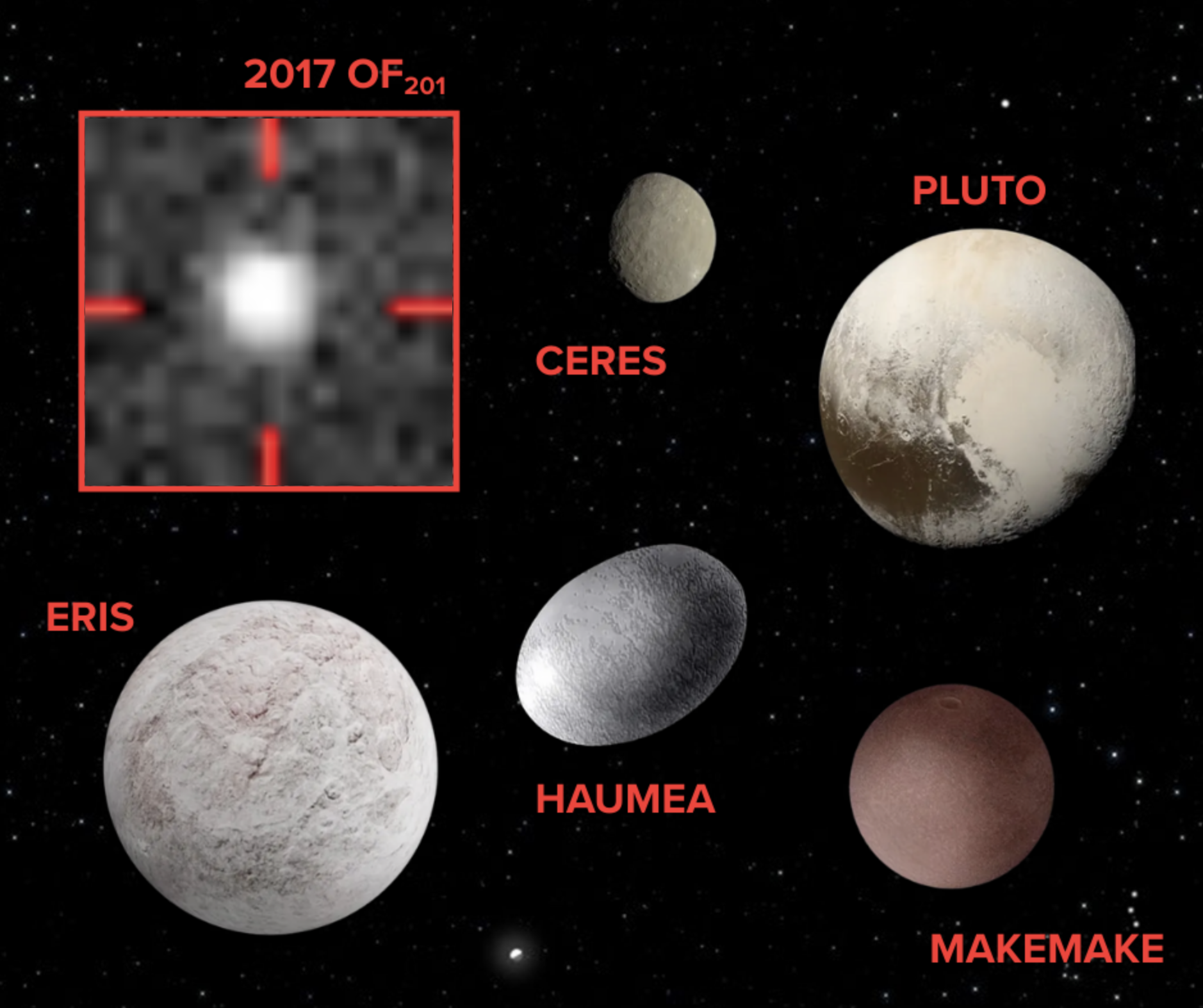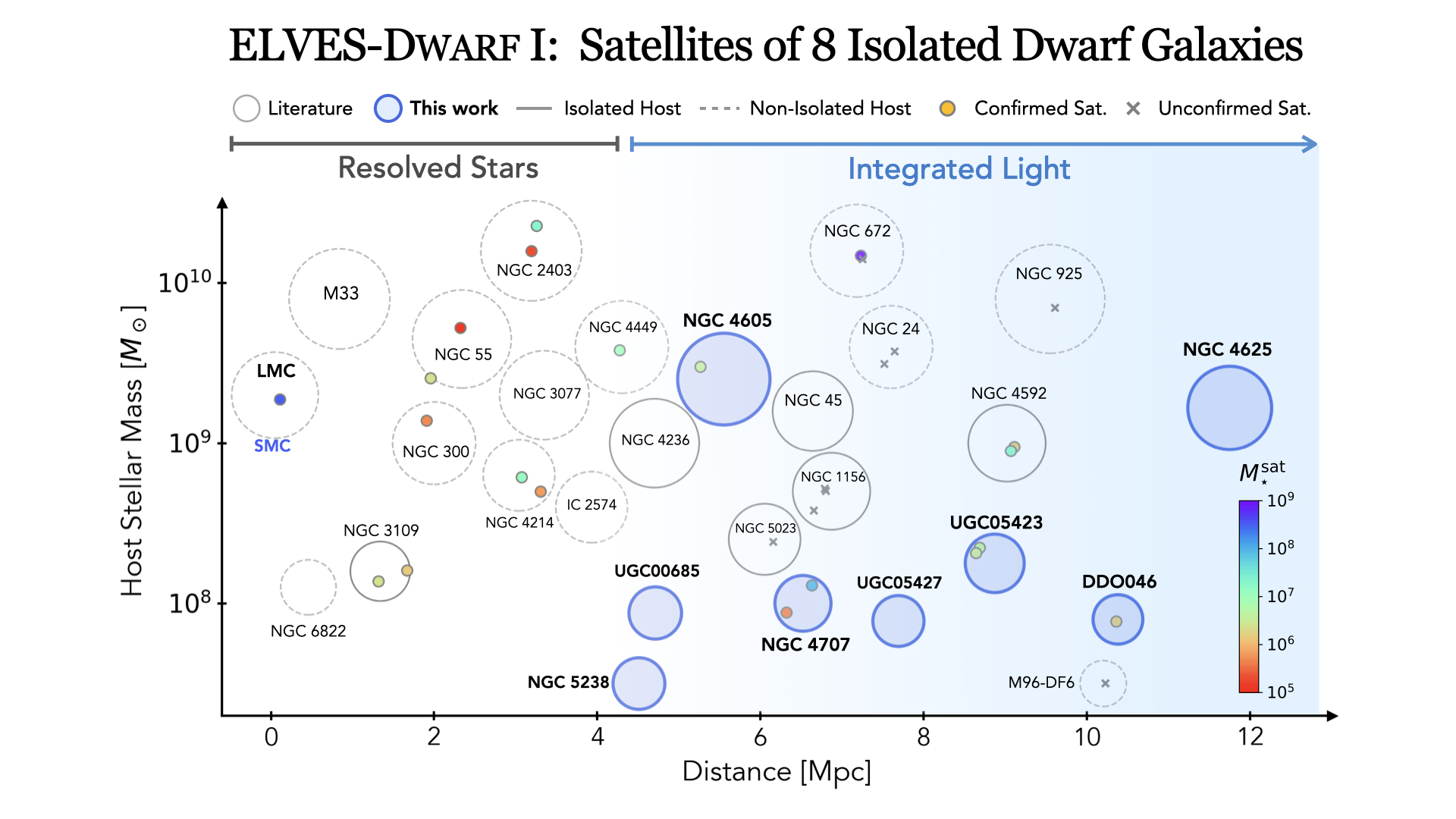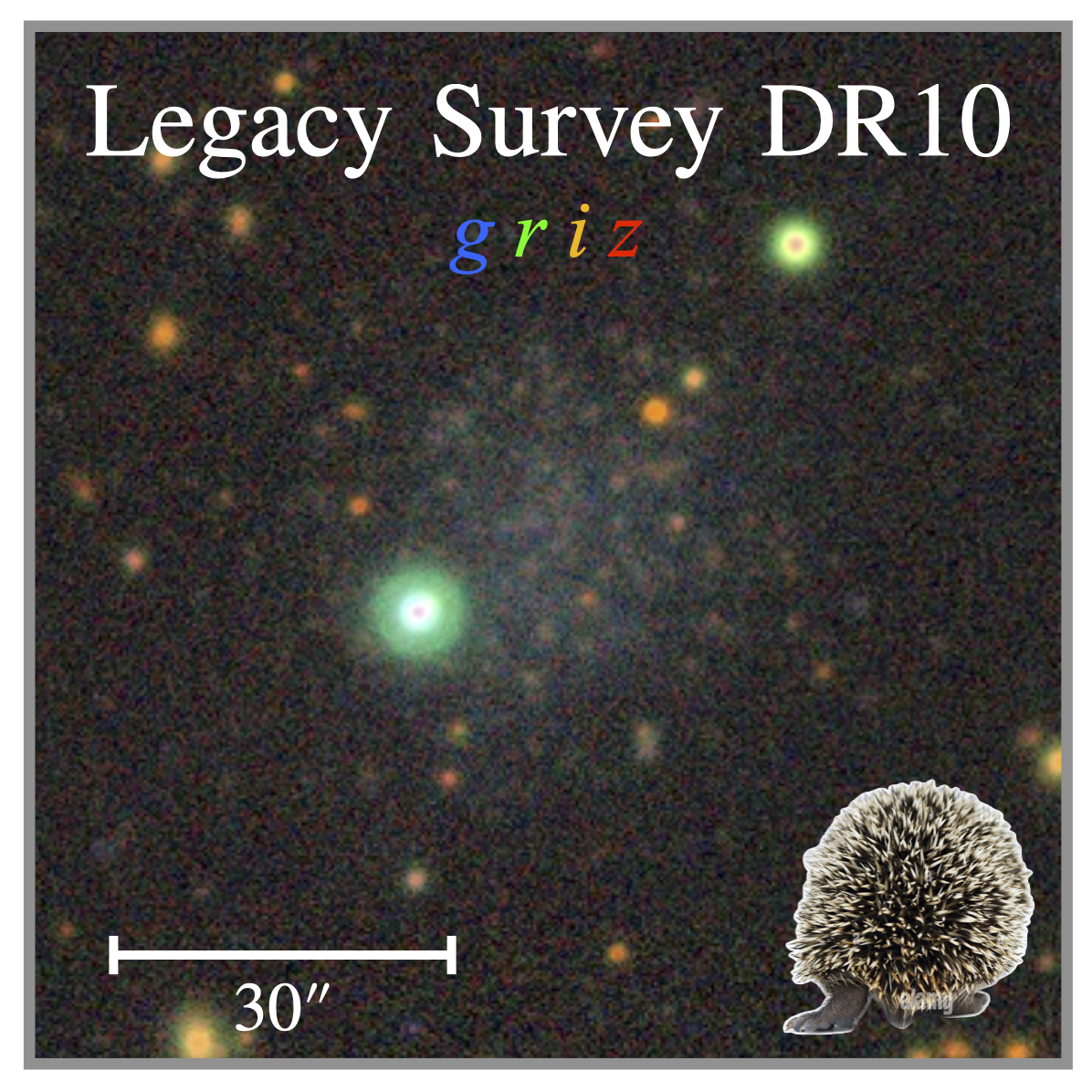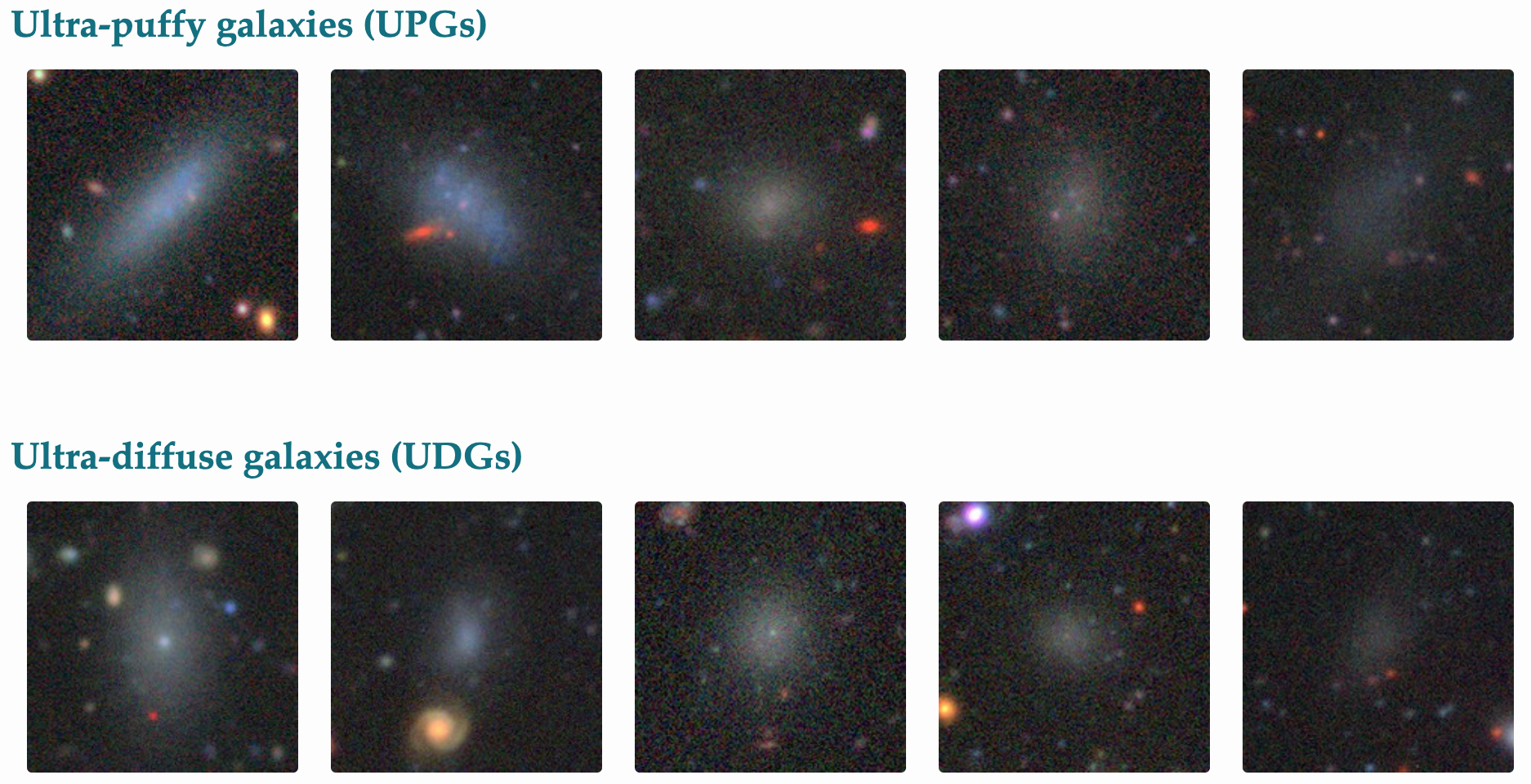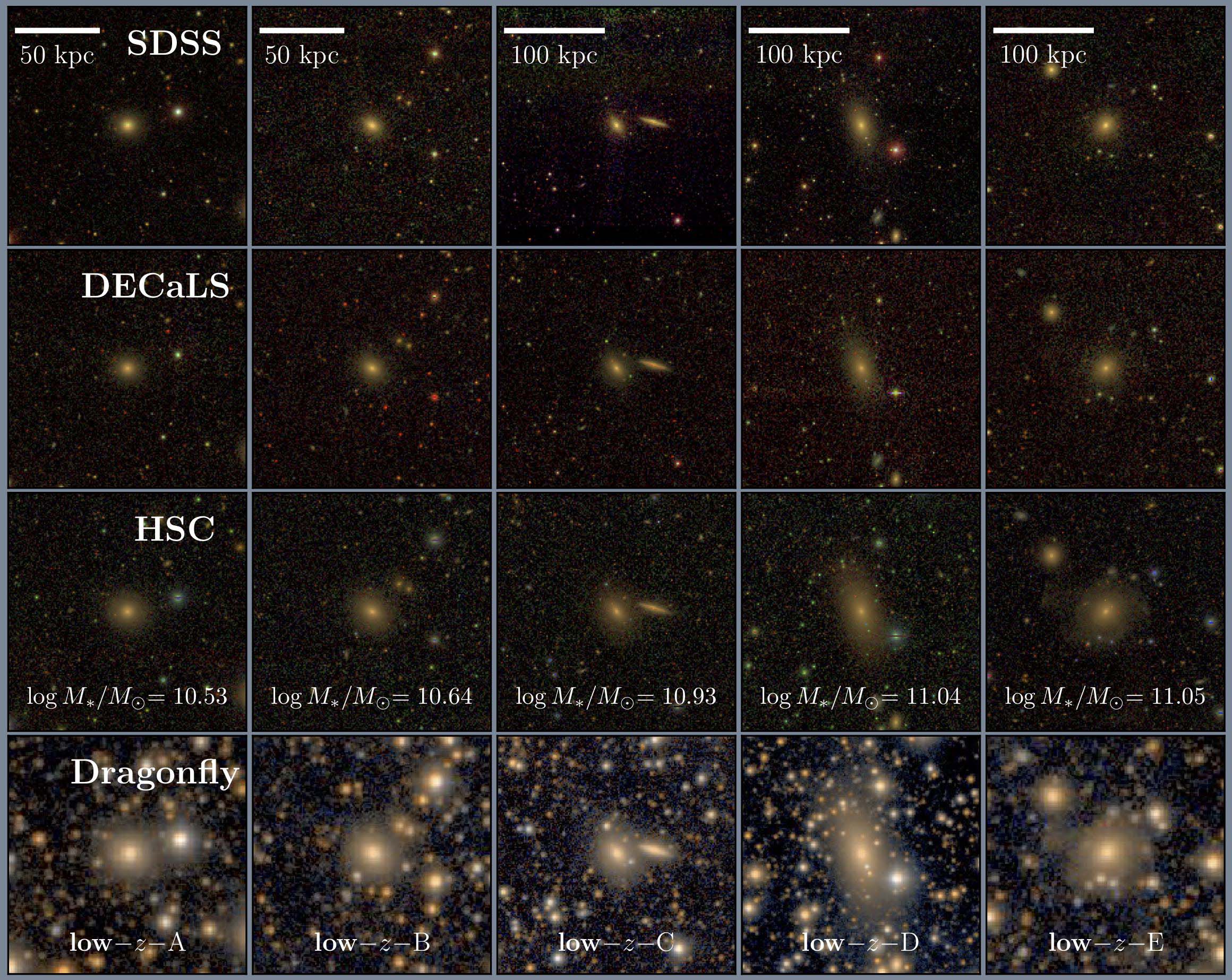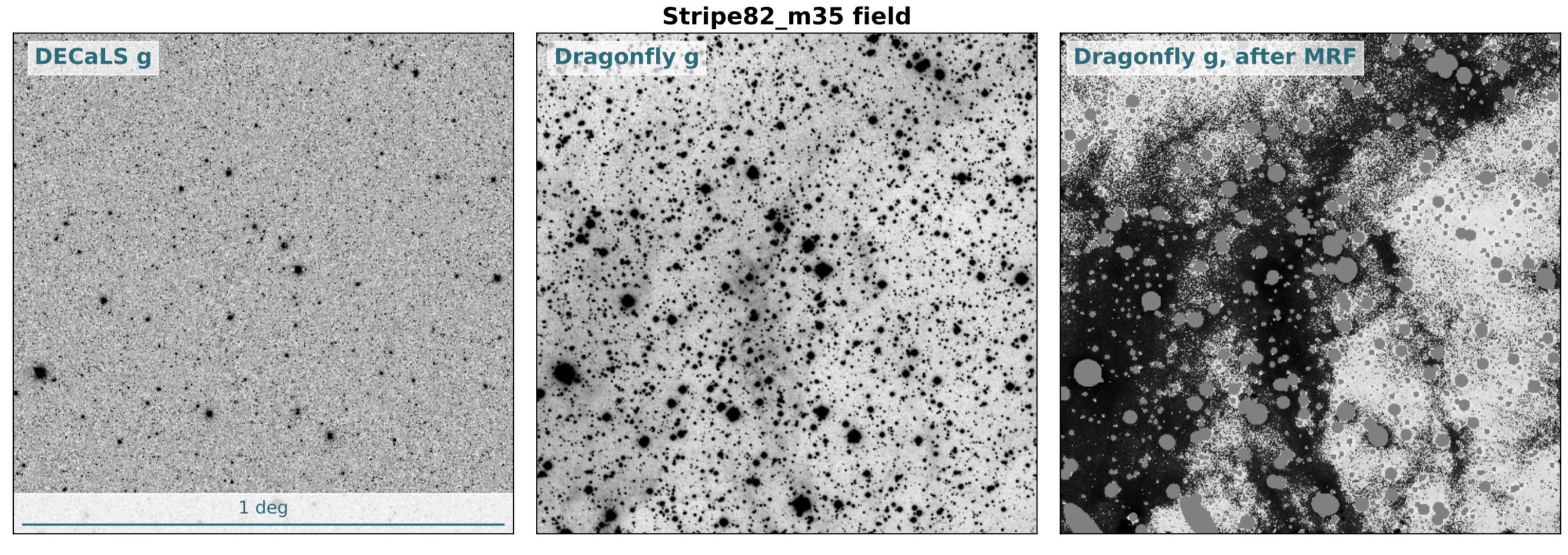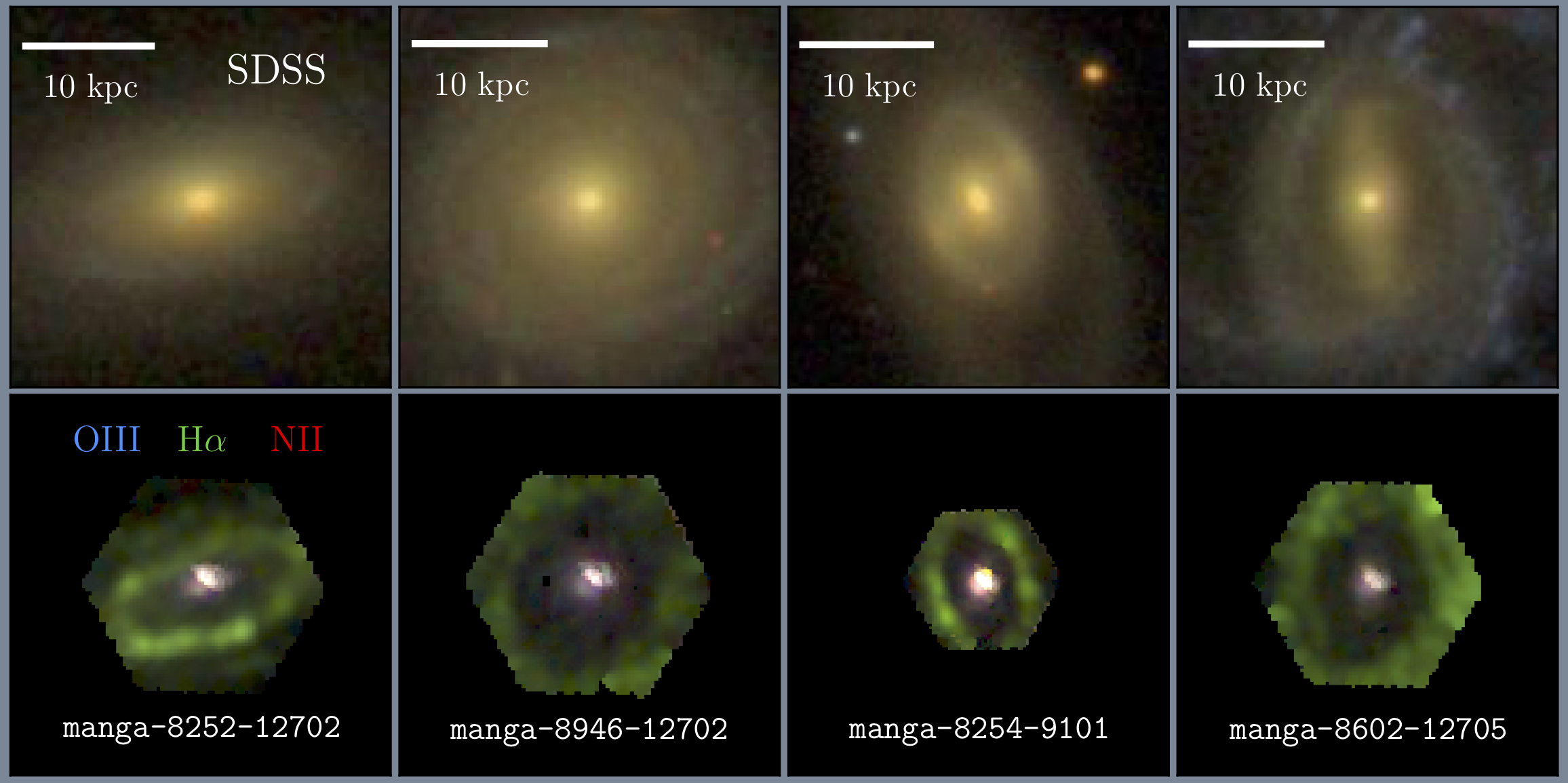Research
Link to my publications in ADS
2017 OF201: Discovery of a Dwarf Planet Candidate in an Extremely Wide Orbit
Led by my longtime friend Sihao Cheng (IAS), together with fellow grad student Eritas Yang (Princeton), we discovered an exceptional trans-Neptunian object (TNO) named 2017 OF201. The discovery is described in Cheng et al. (2025). This TNO was first spotted in the Dark Energy Camera data taken in 2017 as a part of the Dark Energy Camera Legacy Survey (DECaLS), and later confirmed by the archival data from the Canada-France-Hawaii Telescope (CFHT).
With these detections spanning over 7 years, we were able to trace the object’s orbit to a very good precision. This object is in an extremely wide (a ~ 840 au) and eccentric (e ~ 0.946) orbit that takes approximately 25,000 years to complete. At a distance of ~90 au from the Sun now, it has a diameter of about 700 km, assuming an albedo of 0.15. It is potentially large enough to qualify as a dwarf planet like Pluto.
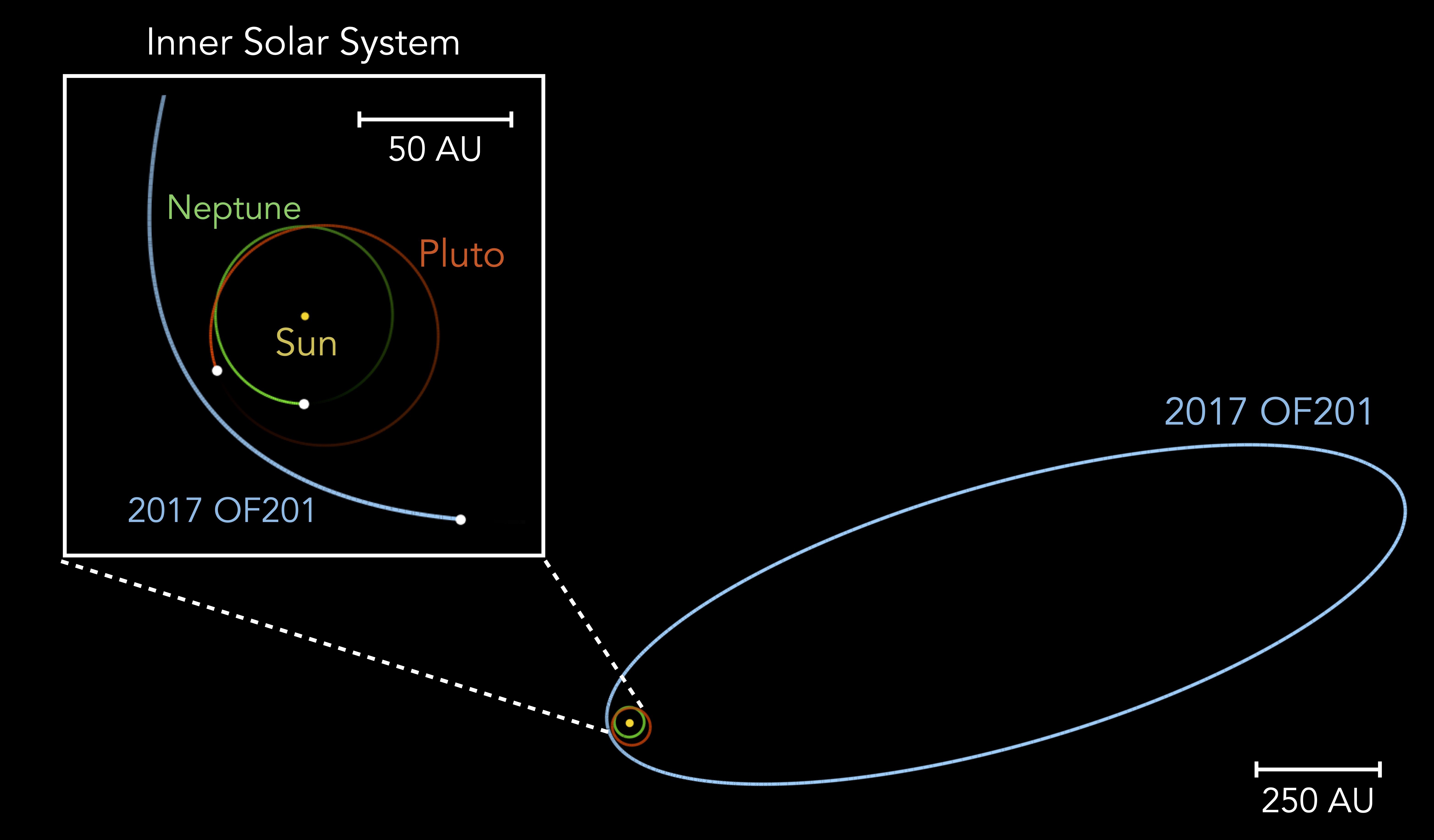
- Image showing the orbits and the current location of Pluto, Neptune, and 2017 OF201.
Figure credit: Jiaxuan Li (Princeton), Sihao Cheng (IAS)
The most striking feature of 2017 OF201 is that its orbit does not following the apsidal clustering pattern observed in many other extreme TNOs (see the figure on the right). This pattern is thought to be caused by the gravitational influence of a massive planet beyond Neptune, or so-called Planet 9 or Planet X. However, 2017 OF201’s orbit is not aligned with this clustering, suggesting that it may have been perturbed by a different mechanism, or it implies that Planet 9/X doesn’t exist.

- Plan view of the orbits of TNOs with extremely wide orbits, including our newly discovered 2017 OF201, which has a distinct orbit is an outlier to the apsidal clustering of the others. For reference, the most probable orbit of Planet X from Siraj et al. (2025) is shown in black. The right panel shows the longitude of perihelion of the known TNOs.
Because of its extreme orbit, 2017 OF201 can be detected by surveys with similar depths to DECaLS for only 0.5% of its orbital period. This means that there are likely a large population of similar objects in the outer solar system that have not yet been discovered. Upcoming wide-field sky surveys, including the Vera C. Rubin Observatory’s Legacy Survey of Space and Time, will unveil many more objects similar to 2017 OF201.
This work is featured in the IAS and Princeton University websites, as well as in New York Times, Sky & Telescope, Phys.org, New Scientist, Universe Today, and many more.
ELVES-Dwarf Survey: Probing Satellites of Isolated Dwarf Galaxies in the Local Volume
The satellite populations of Milky Way–mass systems have been extensively studied. However, the satellites of lower-mass dwarf galaxies remain largely unexplored, despite hierarchical structure formation predicting that dwarf galaxies should host their own satellites. In Li et al. (2025a), we present the first results of the ELVES-Dwarf survey, which aims to statistically characterize the satellite populations of isolated dwarf galaxies in the Local Volume (\(4<D<10\)~Mpc). We identify satellite candidates in integrated light using the Legacy Surveys data and are complete down to \(M_g\approx -9\) mag. We then confirm the association of satellite candidates with host galaxies using surface brightness fluctuation distances measured from the Hyper Suprime-Cam data. We surveyed 8 isolated dwarf galaxies with stellar masses ranging from sub-Small Magellanic Cloud to Large Magellanic Cloud scales (\(10^{7.8} < M_\star^{\rm host}<10^{9.5}\, M_\odot\)) and confirmed 6 satellites with stellar masses between \(10^{5.6}\) and \(10^{8} \, M_\odot\). Most confirmed satellites are star-forming, contrasting with the primarily quiescent satellites observed around Milky Way–mass hosts. By comparing observed satellite abundances and stellar mass functions with theoretical predictions, we find no evidence of a “missing satellite problem” in the dwarf galaxy regime.
Hedgehog: An Isolated Quiescent Dwarf Galaxy at 2.4 Mpc
In Li et al. (2024b), we discovered a new isolated quiescent dwarf galaxy at a distance of 2.4 Mpc! The galaxy, named Hedgehog, has no neighbors within 1 Mpc, and is 1.7 Mpc from its nearest galaxy group Centaurus A, making it one of the most isolated quiescent dwarfs at this stellar mass. The distance is measured using surface brightness fluctuations with both Legacy Surveys and deep Magellan/IMACS imaging data. It has a red optical color, early-type morphology, and shows no UV emission. This indicates that Hedgehog has an old stellar population and is quiescent in star formation. Compared with other quiescent dwarfs in the Local Group and Local Volume, Hedgehog appears smaller in size for its luminosity but is consistent with the mass–size relations. Hedgehog might be a backsplash galaxy from the Centaurus A group, but it could also have been quenched in the field by ram pressure stripping in the cosmic web, reionization, or internal processes such as supernova and stellar feedback.
Please check out the 3-D environment of Hedgehog using this interactive plot: Hedgehog Environment. Also check out the AAS NOVA highlight on this discovery: AAS NOVA.
The YouTube video below also nicely introduces the discovery of Hedgehog (made by a YouTuber, not me!).
PopSED: Population-Level Inference for Galaxy Properties from Broadband Photometry
In Li et al. (2024a), we present PopSED, a framework for population-level inference of galaxy properties from photometric data. Unlike the traditional approach of first analyzing individual galaxies and then combining the results to determine the physical properties of the entire galaxy population, we directly make the population distribution the inference objective. We train normalizing flows to approximate the population distribution by minimizing the Wasserstein distance between the synthetic photometry of the galaxy population and the observed data. We validate our method using mock observations and apply it to galaxies from the GAMA survey. PopSED reliably recovers the redshift and stellar mass distribution of 100K galaxies using broadband photometry within 1 GPU-hour, being 1 million times faster than the traditional SED modeling method. From the population posterior we also recover the star-forming main sequence for GAMA galaxies at \(z<0.1\). With the unprecedented number of galaxies in upcoming surveys, our method offers an efficient tool for studying galaxy evolution and deriving redshift distributions for cosmological analyses.
The code popsed is available on GitHub. If you have any questions, please feel free to open an issue on GitHub or contact me via email.
Our poster for AAS243 has won the Chambliss Astronomy Achievement Student Award!
Beyond Ultra-Diffuse Galaxies II: Environmental Quenching of Mass-Size Outliers Among the Satellites of Milky Way Analogs
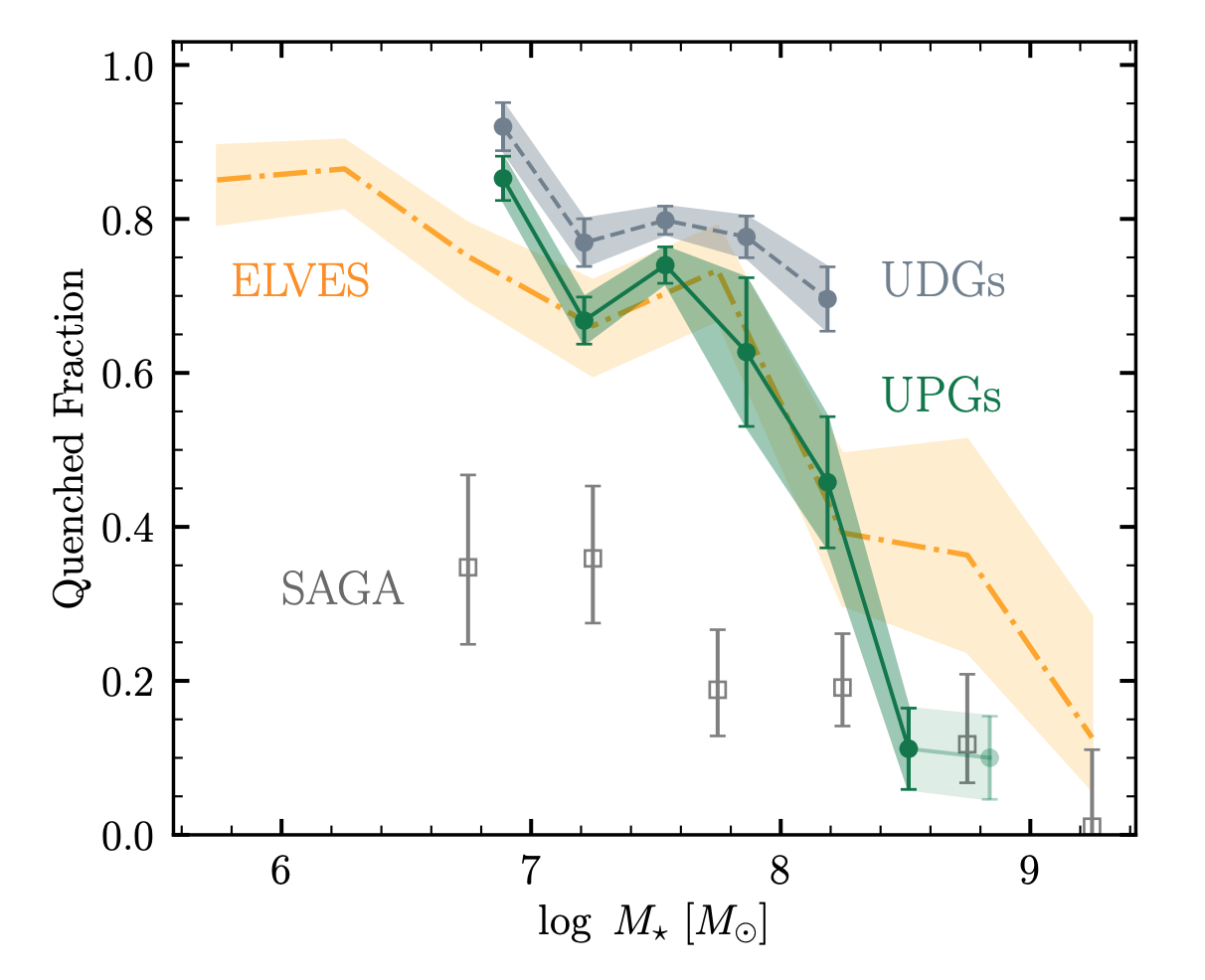
- The quenched fractions of UDGs (gray), UPGs (green), normal-sized satellites (orange) as a function of stellar mass.
In Paper I (Li et al. 2023a), we present a sample of large diffuse galaxies (i.e., ultra-diffuse and ultra-puffy galaxies) around Milky-Way analogs using the exquisitely deep and wide Hyper Suprime-Cam Strategic Survey images. As a follow-up study, in this Paper II (Li et al. 2023b), we explore the statistical characteristics of these mass-size outliers, including their size distribution, spatial distribution, and most importantly, their star formation status. By comparing these distributions with normal satellites of MW analogs, we learn about how mass-size outliers form, and how their star formation is tied to their exotic sizes. We find that, once using the appropriate way to construct the mass-size outlier sample (i.e., selecting then based on the mass-size relation, instead of hard cuts on size or surface brightness), the quenched fraction (the fraction of galaxies that are quiescent in star formation) of mass-size outliers is very similar to normal-sized satellites. This hints that quenching is not tied to being a mass-size outlier. We discuss the possibility where mass-size outliers are formed prior to falling into the current host, and are quenched together with normal-sized dwarfs via ram pressure stripping. The next step is to find ultra-puffy galaxies in simulations, where we can study their formation and evolution in detail.
Beyond Ultra-Diffuse Galaxies I: Mass-Size Outliers Among the Satellites of Milky Way Analogs
Large diffuse galaxies are hard to find, but understanding the environments where they live, their numbers, and ultimately their origins, is of intense interest and importance for galaxy formation and evolution. In Paper I (Li et al. 2023a), we propose a new concept of “ultra-puffy” galaxies (UPGs), defined to be \(1.5\sigma\) above the average mass-size relation. We argue that our definition for ultra-puffy galaxies, based on the mass-size relation, better represent the tail of the satellite size distribution. It is also more physically-motivated than the common definition of ultra-diffuse galaxies (UDGs), which depends on surface brightness and size cuts and thus yields different surface mass density cuts for quenched and star-forming galaxies.
Using Subaru’s Hyper Suprime-Cam Strategic Survey Program, we perform a systematic search for low surface brightness galaxies, and present samples of UPGs and UDGs associated with Milky-Way analogs at \(0.01 < z < 0.04\). The data products are available here. We find that each MW analog hosts \(N_{\rm UPG}=0.31±0.05\) ultra-puffy galaxies on average, which is consistent with but slightly lower than the observed abundance at this halo mass in the Local Volume. The UDG abundance \(N_{\rm UDG}=0.44±0.05\) agrees with local measurements quite well. On average, 7% of the satellites in MW analogs are UDGs, and 5% of the satellites are UPGs. In Paper II (Li et al. 2023b), we present the size and spatial distributions of UPGs and their star formation status.
Reaching for the Edge I: Probing the Outskirts of Massive Galaxies with HSC, DECaLS, SDSS, and Dragonfly
In Li et al. (2022a), we compared the abilities to detect massive galaxy outskirts and related systematics for Hyper Suprime-Cam (HSC), Dark Energy Camera Legacy Survey (DECaLS), Dragonfly Telephoto Array and SDSS. Dragonfly shows outstanding ability on recovering outskirts of low-\(z\) bright galaxies to \(30\ \mathrm{mag/arcsec^2}\). HSC could reach farther than 150 kpc for individual galaxy and 200 kpc for a galaxy ensemble. Good agreements are achieved between HSC and DECaLS profiles of intermediate-\(z\) galaxies down to \(28\ \mathrm{mag/arcsec^2}\ (\sim100\ \mathrm{kpc})\). DECaLS is able to recover the stellar mass within 100 kpc from HSC by only 0.05 dex. This work serves as a good reference for low surface brightness studies using different datasets and benefits future sky surveys.
Multi-resolution filtering: an empirical method for isolating faint, extended emission in Dragonfly data and other low resolution images
We developed an empirical, self-contained method “Multi-resolution filtering” (MRF) to isolate and study faint, large-scale emission in imaging data of low spatial resolution. The method was developed for the Dragonfly Telephoto Array, which produces images that have excellent low surface brightness sensitivity but poor spatial resolution. The resulting image only contains emission fainter than a pre-defined surface brightness limit. The method is implemented in \(\texttt{mrf}\), an open-source MIT licensed Python package. It also contains an well-defined method to determine the surface brightness detection limit on a certain scale. This work is crucial for the future sciences of Dragonfly surveys. Please see van Dokkum et al. 2019 for more details.
Inside-out quenching galaxies with H\(\alpha\) ring-like structures
We investigated galaxies with H\(\alpha\) emission ring-like structures in Mapping Nearby Galaxies at APO (MaNGA) survey, with the stellar mass in the range of \(10.0<\log(M/M_\odot)<11.5\). They are located in the “green valley” and experiencing the inside-out quenching process. We measure the radii of H\(\alpha\) rings and find that bars are just stuck in the H\(\alpha\) rings. High bar fraction, high AGN (Seyfert/LINER) fraction and high bulge-to-total ratio support that the joint effects of bar, bulge and AGN could quench the massive disk galaxies efficiently by the inside-out quenching mode and form the H\(\alpha\) ring-like structure. 🔗Paper Draft
Software Development
-
smplotlib: Matplotlib template for SuperMongo style. Just one line of code to make your plot look like SuperMongo! Also see a thread on Twitter
-
mrf: Multi-Resolution Filtering is a method for isolating faint, extended emission in Dragonfly data and other low resolution images, developed by Pieter van Dokkum and Jiaxuan Li.
-
unagi: Search and download data from Hyper Suprime-Cam (HSC) Subaru Strategic Survey (SSP), developed by Song Huang, Jiaxuan Li and contributors.
-
kungpao: Photometric analysis library for Hyper Suprime Camera (HSC) images, developed by Song Huang and Jiaxuan Li.
-
lvhuo: Image stacking analysis for Hyper Suprime-Cam data, developed by Jiaxuan Li and Song Huang.
-
slug: Integrated tool for calculating 1-D surface brightness profile of massive galaxies, developed by Jiaxuan Li.
-
More works can be found on Github: @AstroJacobLi. Please star if you like them!
